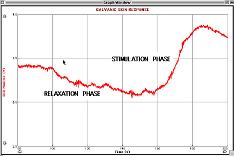
Qubit Systems' S225 Electrooculograph (EOG) is used to monitor eye movement of a stationary subject. A reference electrode is placed on the forehead, electrodes are placed on the right and left temples for lateral eye movement detection, and above and below an eye for vertical eye movement detection. Lateral movement and vertical movement are plotted on different channels as voltages, or the EOG can be calibrated for each subject to provide angles of eye movement in both the horizontal and vertical plane. A convenient reset button allows the instrument to be zeroed when the subject is looking straight ahead.
Like the GSR sensor, the EOG sensor has applications in both physiology and psychophysiology laboratories, and is always extremely popular with students who wish to investigate how mind and muscle interact.
The EOG sensor comes with 3 electrode cables, a set of 100 disposable electrodes, an AC/DC transformer and a laboratory manual. The lab manual outlines the source of the electrical signals and various experiments which can be conducted with the sensor.
Students are fascinated by the electrophysiology of muscles that control eye movement, and more so by the way in which our eyes track and scan objects.
Numerous experiments are possible to determine how different subjects respond to different images. Show the subject an advertising poster and determine how the subject's eyes move to the most important features of the image. Advertisers use EOG devises in poster design. Show the subject a map and ask them to find a particular city, or a group of cities with certain characteristics (e.g. population size). How effective is the legend of the map in helping the subject? How often is the legend consulted? Does the subject scan the map in a specific pattern or more irregularly?

All human electrophysiology and human respiratory monitoringproducts produced by Qubit Systems Inc. are not appropriate for medical or clinical applications.
Producing Area:Canada